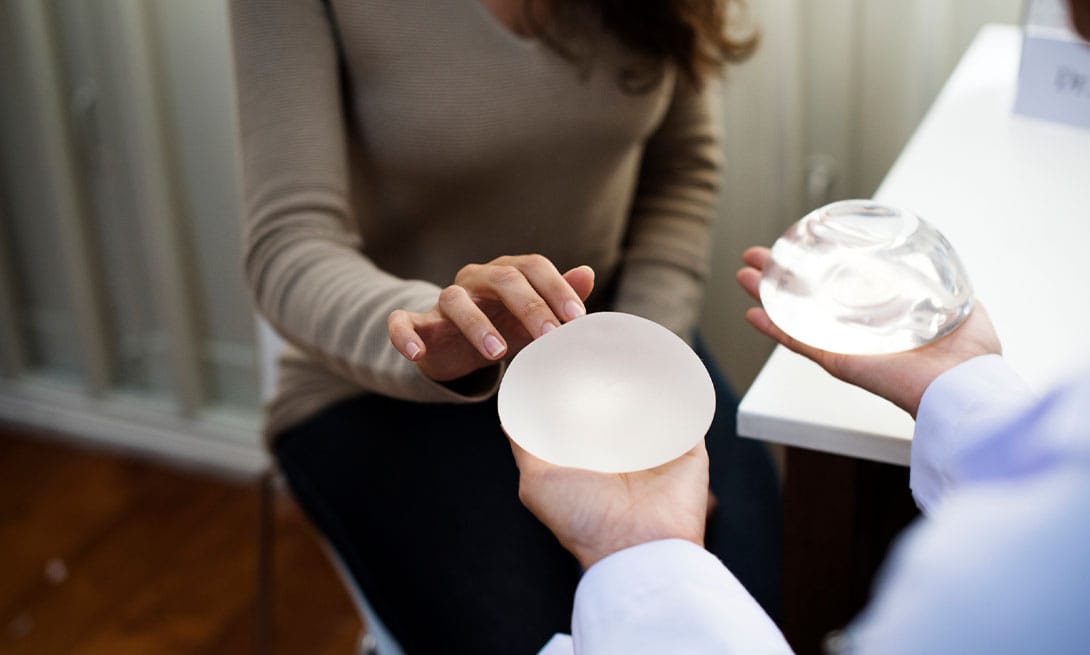Losing one or both breasts to cancer can be emotionally devastating. Beyond the challenges of diagnosis and treatment, you’re faced with another deeply personal decision: whether to rebuild your breasts through reconstructive surgery. You may long to regain your sense of femininity, balance, or normalcy, but you also want to choose a method that fits your body type and goals.
At the New York Group for Plastic Surgery, our surgeons understand that breast reconstruction isn’t just about restoring form: it’s about restoring confidence and wholeness. With extensive expertise in both implant-based and flap (autologous tissue) reconstruction, our team guides each patient through this important decision with compassion. Here’s a closer look at both methods and how to decide which approach is right for you.
Implant reconstruction vs. flap-based reconstruction
Overview
- Implant reconstruction: The breast mound is created using a silicone or saline implant. It’s typically performed in two stages: first, a temporary tissue expander is placed to gradually stretch the skin; then, the final implant replaces it after several weeks. This method avoids tissue harvesting and has a shorter recovery time.
- Flap-based reconstruction: Also known as autologous breast reconstruction, this method uses your own tissue, usually skin, fat, and sometimes muscle, from the abdomen, thighs, or buttocks. These are shaped into a new breast mound, often using microsurgical techniques. The result is a soft, natural-looking breast that feels and moves more like your own.
Appearance and feel
- Implant reconstruction: Implants provide a predictable size and volume, giving you control over your desired breast shape. Silicone implants, in particular, mimic the softness of natural breast tissue. However, implants may feel slightly firmer than natural tissue and don’t change with your body over time.
- Flap-based reconstruction: Because it uses your own living tissue, a flap reconstruction looks, feels, and ages like a natural breast. The tissue will gain or lose weight in sync with your body and provides a more natural texture. For women seeking the most lifelike result, flap reconstruction is often considered the gold standard.
Recovery and downtime
- Implant reconstruction: Recovery is typically faster, as the procedure doesn’t involve donor sites. Most women resume normal activities within four to six weeks. The main limitation is the two-step process: placement of a tissue expander followed by a final implant in a few weeks.
- Flap-based reconstruction: Flap procedures require longer surgery (several hours) and a recovery period of 6 to 8 weeks. Because tissue is taken from another part of your body, you’ll also heal at the donor site. However, many women feel the longer recovery is worth it.
Longevity and maintenance
- Implant reconstruction: While modern implants are durable, they may eventually require replacement due to rupture, leakage, or capsular contracture. The FDA recommends periodic imaging to monitor silicone implants. For many women, implants last 10 to 20 years.
- Flap-based reconstruction: Once healed, flap reconstructions usually last a lifetime. There’s no foreign material that can rupture or require replacement. Because the tissue is your own, it adapts naturally with your body over time and typically requires no long-term maintenance.
Suitability and body type
- Implant reconstruction: Implants are a good choice for women with smaller to medium breasts or minimal excess body tissue. It’s also ideal if you’re not a candidate for longer microsurgery due to medical conditions or lack of suitable donor tissue.
- Flap-based reconstruction: Women with enough abdominal, thigh, or buttock tissue often make excellent candidates for flap surgery. This is particularly beneficial for those who have undergone radiation, as implants in radiated tissue can increase complications.
Potential risks
- Implant reconstruction: Risks of implants include infection, implant rupture, asymmetry, and rare complications such as breast implant-associated anaplastic large cell lymphoma (BIA-ALCL). While these are uncommon, ongoing monitoring is important.
- Flap-based reconstruction: Flap surgery carries a higher initial surgical risk, including bleeding, infection, or flap failure if the transferred tissue doesn’t maintain adequate blood supply. However, there are no implant-related risks, and success rates are extremely high.

How to choose the best breast reconstruction for you
Evaluate your lifestyle and recovery goals
If you prefer a shorter surgery and recovery, implant reconstruction may fit your schedule and comfort level. On the other hand, if you can dedicate more time to healing and want results that feel more natural, flap reconstruction may be worth the investment. Think about your daily responsibilities, physical activity, and long-term goals when deciding.
Consider your medical history and body type
Your health, past treatments, and available tissue play a major role in determining suitability. If you’ve undergone radiation or have enough donor tissue in the abdomen, thighs, or buttocks, flap reconstruction might yield a more durable and natural outcome. For those with limited tissue or complex health conditions, implants may be the safer choice.
Think about long-term maintenance
Implants may eventually require replacement after 10 to 15 years, and they require ongoing monitoring every 2 to 3 years. Meanwhile, flap reconstructions typically do not require ongoing monitoring, and the results last a lifetime. If you prefer a “set it and forget it” approach, tissue-based reconstruction may align better with your goals.
Discuss your aesthetic priorities
Do you want a firmer, fuller breast with predictable symmetry? Implants provide precise control over shape and size. Do you want the softest, most natural feel possible? Flap reconstruction is often the preferred route. Your surgeon will help you visualize both outcomes.
Choose an experienced surgical team
Breast reconstruction requires skill, artistry, and advanced microsurgical expertise. At the New York Group for Plastic Surgery, our board-certified plastic and reconstructive surgeons have performed thousands of successful breast reconstructions using both implant and flap-based techniques. We take the time to carefully understand your priorities and design a personalized plan that restores both balance and confidence.
Choosing between implant and flap reconstruction is a highly individual decision. What matters most is selecting the method that aligns with your body, lifestyle, and emotional recovery. At the New York Group for Plastic Surgery, our compassionate team will guide you through every step of the process, from consultation to recovery, to help you feel whole again. Contact us today to get started.

